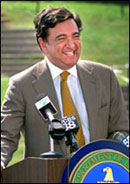There are plenty of ways to blunt pre-election anxiety, but one exercise favored by Beltway insiders is batting around post-election scenarios. When optimistic enviros envision regime change, the big questions are: Who will be on Kerry’s environmental A-Team? And what will be the top priorities on Kerry’s energy and environment agenda?
Of course, people close to the campaign are extremely wary of conjecture, particularly in a white-knuckle race like this one. “What-if scenarios are not a topic of discussion in the halls of the Kerry campaign,” said Beth Viola, a senior environmental adviser to the Democratic candidate. “We’re living and breathing Nov. 2. All eyes are on the ball. This is not the time to speculate.”
That’s not stopping Washington insiders from dreaming up possible picks for the U.S. EPA, Department of Interior, Department of Energy, White House Council on Environmental Quality, and other senior advisory posts. The names running through the rumor mill range from longtime greenies like Robert F. Kennedy Jr. and Deb Callahan of the League of Conservation Voters to the doyenne of environmental philanthropy herself, Teresa Heinz Kerry.

Robert F. Kennedy Jr. —
could he join a Kerry admin?
It’s a cardinal sin in Washington to openly discuss a possible political transition before an election, so Muckraker vowed to keep sources on this matter confidential.
Of course, it doesn’t take much snooping to come up with names like Kennedy and Callahan. They’ve been among the most conspicuous advocates helping to win Kerry the environmental vote.
“It’s customary that people who have been working consistently on a campaign and helping to earn critical votes would stay on through the administration,” said one source who served at an environmental agency under Clinton. “It’s not a quid pro quo necessarily, but it’s the way things tend to be done. The word is that both Kennedy and Callahan are on the shortlist for top positions.”
But other insiders argue that Kerry would be asking for trouble by bringing environmental firebrands into the fold. “Remember, Kerry would enter office knowing very well how divided our country is and Congress is,” said a Kerry adviser. “He’d be looking for peacemakers to put at the head of his agencies, not troublemakers. You don’t buy into a peacemaker when you buy into someone like Bobby Kennedy. He’s a brilliant guy, but his most effective role may be outside the administration.”
Indeed, Kennedy has not exactly exercised rhetorical caution in his criticisms of the Bush administration, as is apparent in the title of his recent book: Crimes Against Nature: How George W. Bush and His Corporate Pals Are Plundering the Country and Hijacking Our Democracy.
“If you’ve been in advocacy and you’ve been very effective by screaming at the top of your lungs to get things done, it’s hard to switch your M.O.,” said another former Clinton official.
As for Teresa, though she has an impressive environmental background, and though rumors of her potential appointment have proven entertaining for the Beltway set, the controversy left in the wake of Hillary Clinton’s role in her husband’s administration would almost definitely rule that out.
Of course, also keep in mind that all cabinet picks, as well as the chair of the CEQ, have to be confirmed by the Senate. Most analysts predict that the Republicans will retain control of the upper chamber after Nov. 2, which could constrain Kerry’s nominee choices. You can count on Sen. James Inhofe (R-Okla.), chair of the Committee on Environment and Public Works, and Sen. Pete Domenici (R-N.M.), chair of the Energy and Natural Resources Committee, doing all they can to characterize Kerry’s nominees as environmental extremists.
Carl Pope, executive director of the Sierra Club, and Phil Clapp, president of National Environmental Trust, agree that activists might not make the cut. “You don’t want to put somebody perceived as an attack dog in a leadership position, particularly in a climate as harshly divided as ours right now. It’s a big red flag,” said Pope. Clapp added: “People with political backgrounds, not activist backgrounds, are a safer bet. Kerry would burn up too much political capital by trying to get controversial nominations confirmed.”
Clapp pointed out that there are plenty of people with political backgrounds who see eye-to-eye with advocates on the substance of environmental policy, and understand the inner workings of bureaucracy to boot. Sure enough, the most credible names on the shortlist for EPA administrator are those who have had state-level government experience, a number of whom were mentioned in an Oct. 23 National Journal article by Carl Cannon titled “The Kerry Cabinet.”

Jeanne Shaheen.
At the top of the list is Jeanne Shaheen, former Democratic governor of New Hampshire, who launched a number of strong environmental initiatives during her gubernatorial tenure and is now national chair of the Kerry campaign and close to the candidate. Katie McGinty, head of the CEQ under Clinton, is also up there, as is Jonathan Lash, former co-chair of Clinton’s President’s Council on Sustainable Development, former commissioner of the Vermont Department of Environmental Conservation, and current president of the World Resources Institute (he also happens to be on the board of trustees at the Heinz Center for Science, Economics, and the Environment). New York Attorney General Eliot Spitzer (D) could also be tapped (his controversial persona notwithstanding), as could Brad Campbell, commissioner of New Jersey’s Department of Environmental Protection. Another name being bandied about is John DeVillars, the New England regional director for the EPA under Clinton, who happened to serve as Massachusetts’ secretary of environmental affairs when Kerry was the state’s lieutenant governor.

Bill Richardson.
The likeliest candidates to head the Department of Interior, like almost all former interior secretaries, have Western roots, given that the majority of DOI’s lands are in the Western states. At the top of that list are Rep. Tom Udall (D) of New Mexico and Rep. Mark Udall (D) of Colorado, who share a strong legacy: Stewart Udall, Tom’s father and Mark’s uncle, served as secretary of the interior in the Kennedy and Johnson administrations. New Mexico Gov. Bill Richardson (D) (former energy secretary under Clinton) and Washington Gov. Gary Locke (D) are also well-credentialed candidates.

Jeff Bingaman.
Then there are the dual-purpose candidates — those who might fit in at the Department of Energy as well as at Interior. New Mexico Sen. Jeff Bingaman, ranking Democrat on the Senate Energy and Natural Resources Committee, is a top contender for both jobs. So is former Colorado Sen. Tim Wirth (D), who ran the global affairs bureau for the State Department under Clinton, in which capacity he helped to negotiate the Kyoto Protocol, and who now runs Ted Turner‘s U.N. Foundation. Wirth not only has ties to Kerry but worked closely with Teresa’s former husband John Heinz on environmental issues when the two were Senate colleagues.

Carol Browner.
Another name floating around for energy secretary is first-term Michigan Gov. Jennifer Granholm (D), who has already made good headway on environmental matters in her auto-industry state (and has also managed to become so popular that she may not be ready to give the job up). Another strong possibility is Carol Browner, EPA administrator under Clinton, who has been a close adviser to and avid supporter of the Kerry campaign, and is vocal in her enthusiasm for Kerry’s energy vision. (Kerry hasn’t been shy about borrowing from the Clinton-era brain trust, given that his top campaign advisers include Mike McCurry, former press secretary to Clinton, and former Secretary of State Madeline Albright.)
Damage Control is Job One
More easy to predict than cabinet picks are the top environmental concerns for a Kerry administration.
“The number one priority will unfortunately have to be troubleshooting the Bush record,” Viola told Muckraker. “Kerry would have to spend a lot of his energy at the outset undoing that four years of environmental policy.” She mentioned the following goals in no particular order: Kerry would reverse the mercury and new-source-review rollbacks, reestablish funding for Superfund, address the maintenance backlog in national parks, and begin implementing his energy plan, which would likely include a domestic strategy for curbing greenhouse-gas emissions and a strong effort to reengage the international community in climate-change negotiations.
The latter is what Kerry himself named as his top environmental priority going into office in a Rolling Stone interview last week: “Number one is global warming.” But when asked if the era of the internal combustion engine is ending, Kerry replied cautiously: “I wouldn’t make that kind of a bold pronouncement … I mean, we’re going to be drilling oil and natural gas for 40 or 50 years to come, at least. But … we’re going to move rapidly to … reduce our fossil-fuel base as fast as we can.” There was no mention of his aggressive plan to improve auto fuel-economy standards, nor his pledge to get America producing 20 percent of its energy from renewable sources by 2020.
Viola cautioned that when Kerry enters office “there will be an inevitable reality check given the budget situation,” considering huge demands on spending for the war, his health-care program, and so forth. “By no means would he modify his energy and environmental goals, but he has to be realistic about when and how he moves toward them, and deal with first things first.”
There’s no question that if Kerry gets elected he will be jumping from the campaign frying pan into the commander-in-chief fire. He would be inheriting a hell of a lot of problems, and it’s perfectly understandable that he would have to be cautious in the way he implements his environmental vision. Let’s just hope it wouldn’t get pushed to the back burner.
